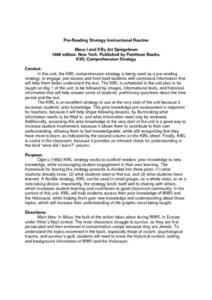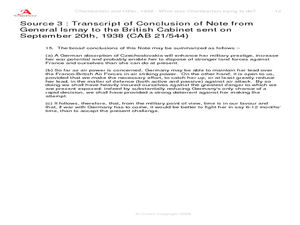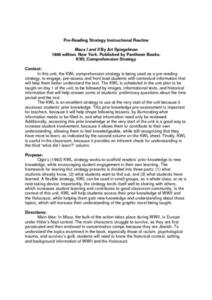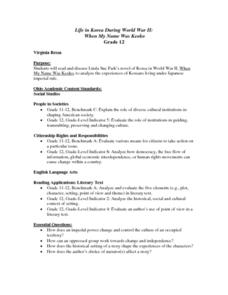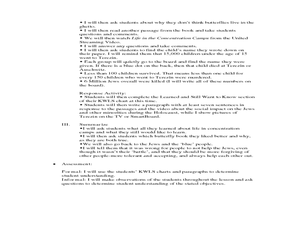Curated OER
Vocabulary Strategy Instructional Routine: Maus I and II
Pogrom, schlepped, meshuga. Kapo, reich, Wehrmacht. As part of a unit study of Maus I and II, readers use a list-group-label (LGL) strategy for vocabulary drawn from Art Spiegelman's famous graphic novels. The focus of the activity is...
Curated OER
KWL Comprehension Strategy: Maus I and II
How much does your class know about World War II? Before reading Art Spiegelman's Maus I, lead your class in creating a KWL chart. Knowing the background and setting of the novel are extremely important in understanding this survivor's...
Curated OER
Maus I and II: Pictionary
Why is visual literacy so important in understanding Maus? Introduce your class to basic elements of graphic novels with a game of pictionary. A list of 13 words are included, but you could potentially add some World War II-related...
Curated OER
Pre-Reading Strategy Instructional Routine: Maus I and II
Vladek's attitudes are difficult for many young learners to understand. Prepare your class for the events represented in Art Speigelman's graphic novel with a pre-reading activity that has them read articles about and interviews with...
Curated OER
End of World War II
Ninth graders examine the results of the Yalta Conference on Europe after the war. They develop a PowerPoint presentation that compare the effects of World War I and World War II. They write a journal entry taking the point of view of...
Worksheet Web
Analyzing the Text
Practice analyzing informational text with a reading passage that details the Great Depression. Scholars read about the impacts of World War I, the Roaring Twenties, and the Depression, then answer 10 true or false questions.
Curated OER
Chamberlain and Hitler, 1938--What Was Chamberlain Trying To Do?
Explore events prior to World War II. Learners view replicas of authentic photographs and hand written documents representing the viewpoints of Adolf Hitler and Neville Chamberlain. They discuss alternate viewpoints, consider historical...
EngageNY
Inferring Author’s Opinions and Writing Opinion Statements: Journalists’ Opinions about Segregation Post–World War II (Promises to Keep, Pages 22–25)
Let's play ball! Scholars summarize information from Promises to Keep about segregation in professional baseball after World War II. They then listen as the teacher reads pages 22-25 aloud. Pupils write the gist in their journals of...
Curated OER
The War: Japanese Americans and Internment
Students examine the experiences of Japanese-Americans at the beginning of World War II in America. After watching an excerpt from "The War", they answer reflection questions about the Japanese being put into internment camps. In groups,...
Curated OER
Maus I and II: KWL Pre-Reading Comprehension Strategy
Prior to reading Maus I and II, class members fill in a KWL chart to determine what they want to learn and how to find information about World War II and the Holocaust. Consider gathering packets of information and research sites before...
Constitutional Rights Foundation
The Cold War: How Did It Start? How Did It End?
What is the difference between a Cold War and a Hot War? Scholars research the beginning of the Cold War. They analyze diary entries as well as excerpts from various events during the 45-year standoff. To finish, they prepare final...
Curated OER
Letters From the Front Lines
Students read a variety of letters from soliders who were on the front lines during World War II. After viewing an excerpt from "The War", they answer discussion and comprehension questions based on the letters and video. To end the...
Curated OER
A Passport to WWII and the Holocaust
Students explore the Holocaust. In this interdisciplinary lesson, students research Hitler's rise to power, the terror of concentration camps, and World War II. Students read The Diary of Anne Frank , listen to a Holocaust survivor, and...
Curated OER
Maus: Cubing Questioning Strategy
Maus is the text for a postreading activity that has class members using a cubing strategy to analyze, in depth, topics (racism, past and present, forgetting/remembering the Holocaust, representing the Holocaust) associated with Art...
Curated OER
Life in Korea During World War II: When My Name Was Keoko
Twelfth graders review facts about roles of Asia and Japan in World War II, read When My Name Was Keoko to familiarize themselves with daily life and historic events during World War II in Korea, and participate in student-led...
State Library of Ohio
All the Light We Cannot See Toolkit
Anthony Doerr's Pulitzer Prize-winning novel All the Light We Cannot See is the focus of a toolkit that provides readers with a summary of the plot, background information about the author, and discussion topics.
Curated OER
World War II: America on the Home Front
Eleventh graders gain a sense of historical time and historical perspective as they study the massive campaign that the U.S. government launched to convince Americans to conserve, participate, and sacrifice. They study cencorship, and...
Core Knowledge Foundation
Unit 8: Code Talker by Joseph Bruchac Teacher Guide
Joseph Bruchac's Code Talker tells the remarkable story of Navajo Marines' role in battles of the Pacific Theater during World War II. As scholars read the novel, they also engage in activities that expand their knowledge of Navajo...
Reed Novel Studies
Lily's Crossing: Novel Study
War affects much more than just soldiers. Lily and Albert in Lily's Crossing know that better than anyone as World War II affects both of them in different ways. Scholars use vocabulary words, answer questions, and work with literary...
Penguin Books
Teacher’s Guide: The Diary of a Young Girl The Definitive Edition By Anne Frank
A line from Anne Frank's diary reads, "What is done cannot be undone, but one can prevent it happening again." Indeed, that is the hope for scholars who study her diary. The 19-page guide to the Definitive Edition of The Diary of a Young...
Curated OER
Political and Social Impact of World War II
Sixth graders study the life in Jewish ghettos during World War II and learn about tolerance and compassion. In this WWII activity, 6th graders discuss Jewish ghettos but with a mistreatment of the kids with stickers to signify the...
Curated OER
The History of Ethanol in America
Sixth graders explore and examine the production of biofuels from the 1850's to the present. Included in their research is Henry Ford, ethanol, World War I and prohibition. They explain the importance of grains and grasses for the...
Curated OER
Maus: A KWHL Approach
After reading the introduction to Maus I, class members use A KWHL approach to determine what they know, what they want to know, and where they can find information about World War II, the Holocaust, and other topics associated with Art...
Penguin Books
An Educator's Guide to The Green Glass Sea by Ellen Klages
A lot of secrecy shrouded the creation of the atomic bomb. Readers uncover some of that secrecy using an educator's guide for the novel The Green Glass Sea. Three weeks of lesson plans feature discussion questions and reading...

